Don’t let copper stamps distract you from finding the best deals out there.
I’ve built much of this site around the (really enjoyable) process of researching copper stamps and fleshing out the story behind the antique and vintage copper pots that survive to the present day. I’m drawn to copper pieces that carry clues to their history, and I know others are too: in general, the prices of stamped pieces are higher than those without.
But I’d like to present a counterpoint: Backstory doesn’t make copper work any better. Copper’s innate qualities dictate how it absorbs and transfers heat, and the amount of copper in the body of the pan relative to its dimensions determines how the pan performs as a cooking vessel. If I lionize names like Jules Gaillard and Paul Legry and Ernest Dehillerin and Jean-Baptiste Jacquotot, it’s because these names can (often) be a shortcut to identify pieces with a mass-to-dimensions ratio that makes them perform the way that French chefs like.
But if you take away the stamp, does the pan perform differently? If you compare an unstamped pan to a Gaillard or Legry or Dehillerin or Jacquotot of the same mass and dimensions, does the name-brand pan perform better? No and no.
Take a look at these two windsors.
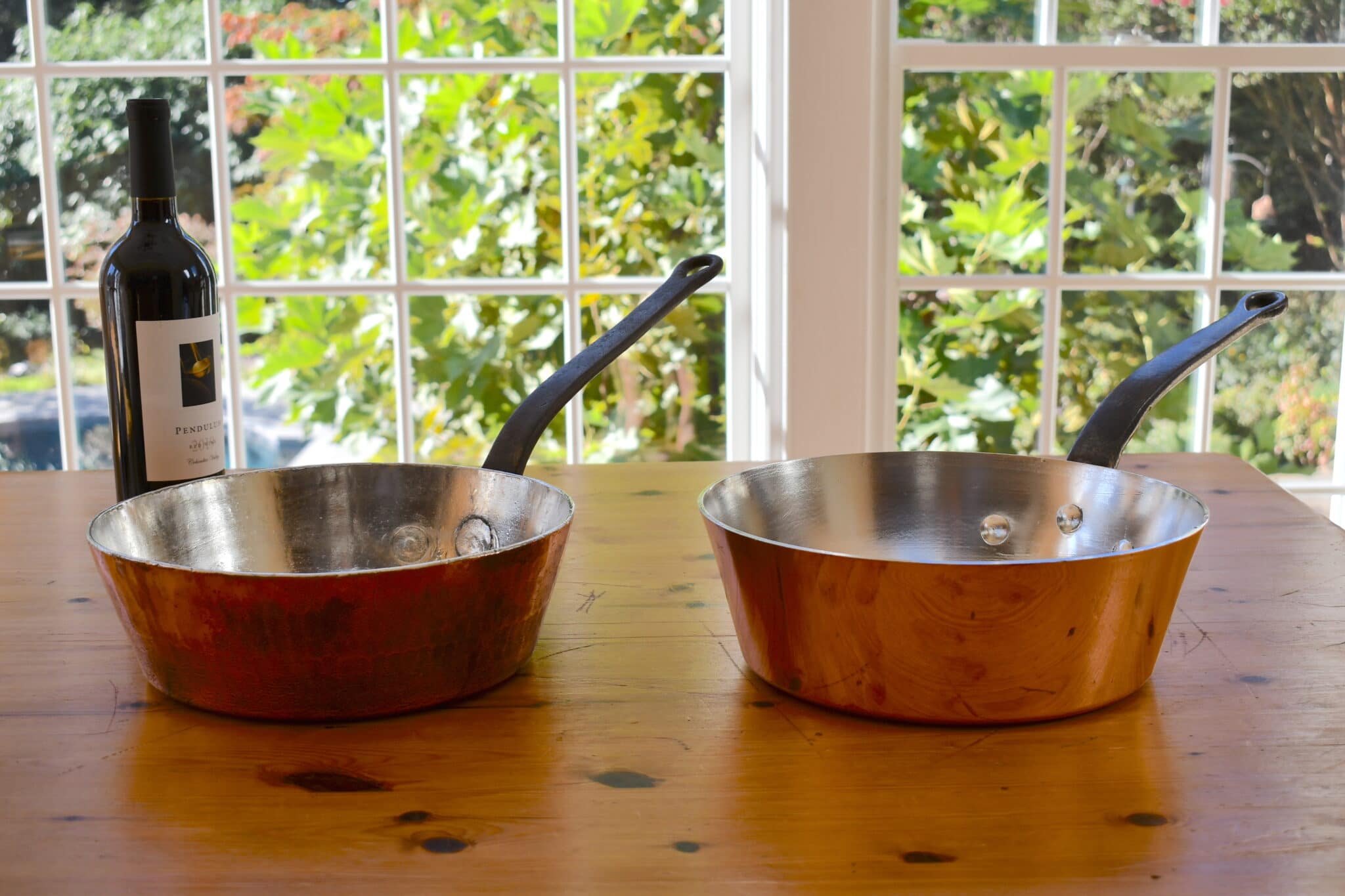 |
|
|
27cm diameter $42 per lb |
28cm diameter $19 per lb |
Functionally these pans are essentially identical. The Gaillard is a little thicker than the no-name but I don’t think this makes an appreciable difference in performance. (Arguably, the Gaillard’s extra pound and a half of weight could be considered a liability for a home cook.) Other differences are cosmetic: the Gaillard’s a bit older than the no-name and has larger rivets with flat internal heads while the no-name has post-WWII mushroom-head style; the Gaillard has a hammered finish while the no-name piece is polished smooth. These qualities don’t make any difference for cooking.
And yet the Gaillard was more than twice as expensive than the no-name, pound per pound, because that’s what collectibility does to copper prices. Gaillard is a collectible marque of copper, and I predict this pan will continue to command a price premium over others with lesser provenance. But if you are looking for extraordinary pieces for your working batterie de cuisine, you can’t beat this no-name windsor at less than half the price.
So why pay more for a stamped pan?
If your number one priority is to recoup (or improve upon) your investment by reselling a piece down the line, head on over to my collectibility page for my opinion on the factors that make that more likely.
But if your number one priority is to get “the copper cooking experience” at the best price possible, then shop by weight. And I don’t mean buy the heaviest — I mean, buy the piece that’s right for you regardless of what’s stamped on it. Decide what size and thickness of copper you want, learn the weight of pans in that range, and use that information to focus on pieces that will fit your needs.
With that in mind, it’s ready, aim, fire.
Ready: Know your cooking
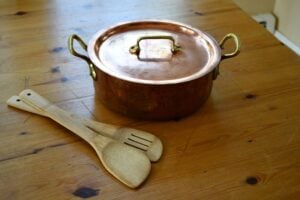 This is my beloved 22cm rondeau. Don’t let its petite size deceive you: this is my kitchen workhorse. Why? Because it’s perfect for the most frequent cooking I do.
This is my beloved 22cm rondeau. Don’t let its petite size deceive you: this is my kitchen workhorse. Why? Because it’s perfect for the most frequent cooking I do.
My household is small and on most evenings I cook for just two people. This is the pan I reach for when I cook proteins that need to simmer in sauces, from chili to braises to Indian food. The flat edge-to-edge floor space means I can brown two or three pieces of protein without crowding them — there is enough room so that steam can dissipate between individual pieces of chicken or beef or whatever. When I add vegetables and liquid for the sauce, the compact shape ensures the proteins sit deep in the liquid so the flavors can fuse and blend. By weight this little guy cost me $40 per lb (€33 per kg), putting it in the upper range of what I’ve paid for a rondeau, but in terms of price paid per meal cooked this is the best bargain in my entire collection.
Your household is different from mine, of course. But if you’re looking to invest in that perfect pieces of copper that you reach for again and again, the volume of food you cook on a regular basis is a good starting point for your functional requirements. Based on my experience, this is what I would suggest.
| People in household | Diameter for a rondeau or sauté pan |
|---|---|
| One to two | 22cm to 24cm |
| Three to four | 26cm to 28cm |
| Five to six | 30cm to 32cm |
Bear in mind that if you’re going to invest in just one copper pan, you might consider a larger size to give yourself some flexibility. My small 22cm rondeau can cook generously for two, would be a tight squeeze for three, and is too small for four. If I could have just one rondeau for my small household, I’d size up to a 28cm — it would be spacious for my every day cooking but I can also use it for dinner parties or batch cooking.
Aim: Know your target thickness
The second reason why I love my little 22cm rondeau so dearly is that it’s a full 3mm thick. People who cook with copper like to say that thick copper is more forgiving because the more copper there is in the pan, the more heat it absorbs and the more slowly it heats up and cools down. As a novice cook, I like that moderated responsiveness because it helps prevent me from burning food: the temperature change on the pan surface happens steadily and evenly across the entire surface so I have more time to observe what’s happening and moderate the heat input as needed. So that’s the other reason why I reach for this little 22cm piece again and again: I trust it to help me cook correctly, even if the recipe is new to me, even if I’m a little distracted, even if I need a few minutes away from the stove. If it seems like I’m a little unreasonably affectionate about this one pan, it’s because it has saved my bacon (literally and figuratively speaking) many times.
That experience is the reason why I encourage you to seek out thicker pieces of copper. I suggest a minimum of 2.5mm thickness for all-purpose home cooking, and thicker if you can find it (and have the arm strength to manage it). But thickness makes more sense for some pieces than others — here are my suggestions.
- 2mm is fine for liquid-based cooking: stockpots, poaching pans, and the like. Pots filled with water (or stock or poaching liquid) do not need the heat management benefits of copper. Water absorbs a lot of heat and distributes it very effectively (you can’t scorch water!). Larger pieces, like truly cavernous stockpots, do benefit from being thicker for structural rigidity, but if you’re looking for a decent-sized home cooking stockpot (say, 24-28cm diameter), 2mm is perfect.
- 2.2mm and above is good for saucepans, but aim for as thick as you can afford. Yes, saucepans are technically for “liquid-based cooking,” but as we all know, sauces and stews can be thick. A chunky sauce or stew doesn’t have the same nimble internal convection currents as clear water or thin broth and can scorch where pockets of steam form against the pot. Thicker copper helps spread out heat and prevent the hot spots that enable scorching (assuming you aren’t overheating the pot).
- 2.5mm and thicker is ideal for browning. I say this because browning shouldn’t become burning, and burning is exactly what good thick copper is there to help you avoid. As copper gets thicker, it absorbs more heat and equalizes it through the entire body of the pan, all the way up the sidewalls to the rim. Sautéing is the ideal match for thick copper — I find that a thick sauté heats up quickly and spreads the heat uniformly over the entire floor of the pan.
- 2.5mm is great for skillets, but 2mm might work better for you. I say this for two reasons: 2.5mm skillets are heavy, which may make it uncomfortable for you to toss and flip; and 2.5mm skillets are less responsive, which may go against your cooking requirements if you want rapid heat response. By that I mean that a 2.5mm skillet will take a few seconds to start cooling off when you lift it from the heat — if you’re working with a delicate crepe or whatever, you might prefer a 2mm skillet that will start dropping temperature immediately when you lift it off the heat. Know your cooking style, know how thickness affects responsiveness, and aim for the thickness that’s right for you.
- 3mm in any pan, in my opinion, is the sweet spot for the “copper experience.” This is where no-name copper can be the answer — heavy copper will generally be more expensive than thinner copper, but avoiding the “name brand” price premium may put pieces in reach.
For more on my recommendations, please see “What should I buy?”. If you’re looking for data on different sizes and types of pan, please take a look at my reference measurements. It’s a bear of a page (and a perpetual work in progress) but my hope is that it will help you get a feel for the relationship between size and mass.
Fire: Buy the right stuff for you
When you have a target size and target thickness in mind, you can focus your searches for pieces that meet that criteria.
Weight is crucial. You need to know the weight of the body of the pan by itself. Lids are great — we all love lids — but they don’t have any effect on the cooking performance. Most sellers weigh pan and lid together (if there is a lid); sellers also use approximations (“almost five kilos”; “three pounds six ounces”). Ask for the weight of the pan alone, in grams if possible, and compare it to reference weights to get an idea of how thick the piece is likely to be.
Measured thickness is helpful, but can be misleading. It’s tough to measure rim thickness accurately, and if the base of the pan is thicker (which is a good thing) the rim thickness isn’t representative of the piece’s effective thickness anyway. Experienced copper sellers are more likely to measure accurately, but even so, weight is a better predictor of the piece’s mass and, by extension, cooking performance.
Ask the seller questions. Use the site’s internal email system to contact the seller with questions. I start with the assumption that sellers aren’t intentionally omitting details — they may not know what’s important to lay out in the listing. In my experience, reputable sellers are happy to provide more information in order to facilitate a durable sale; sellers who withhold information, or act like it’s too much trouble, aren’t worth your business.
I have a whole section of the site for Buying and selling online with advice based on my experience. I hope it helps you!
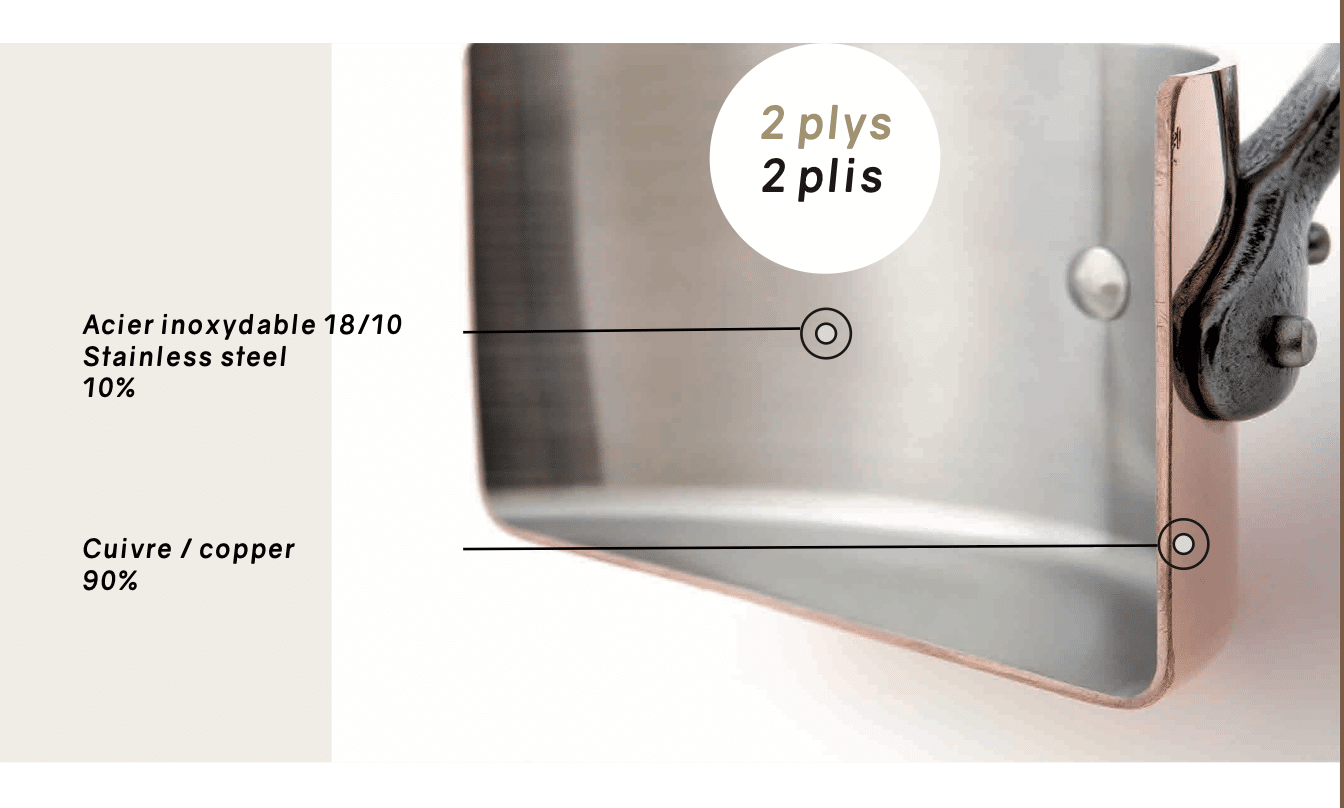
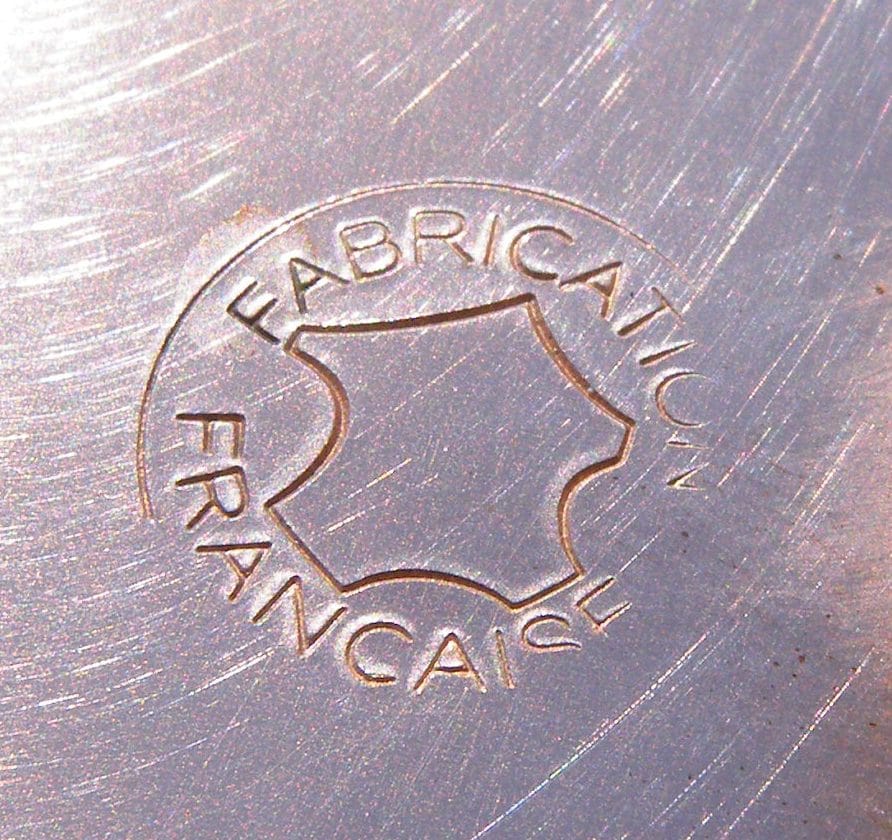
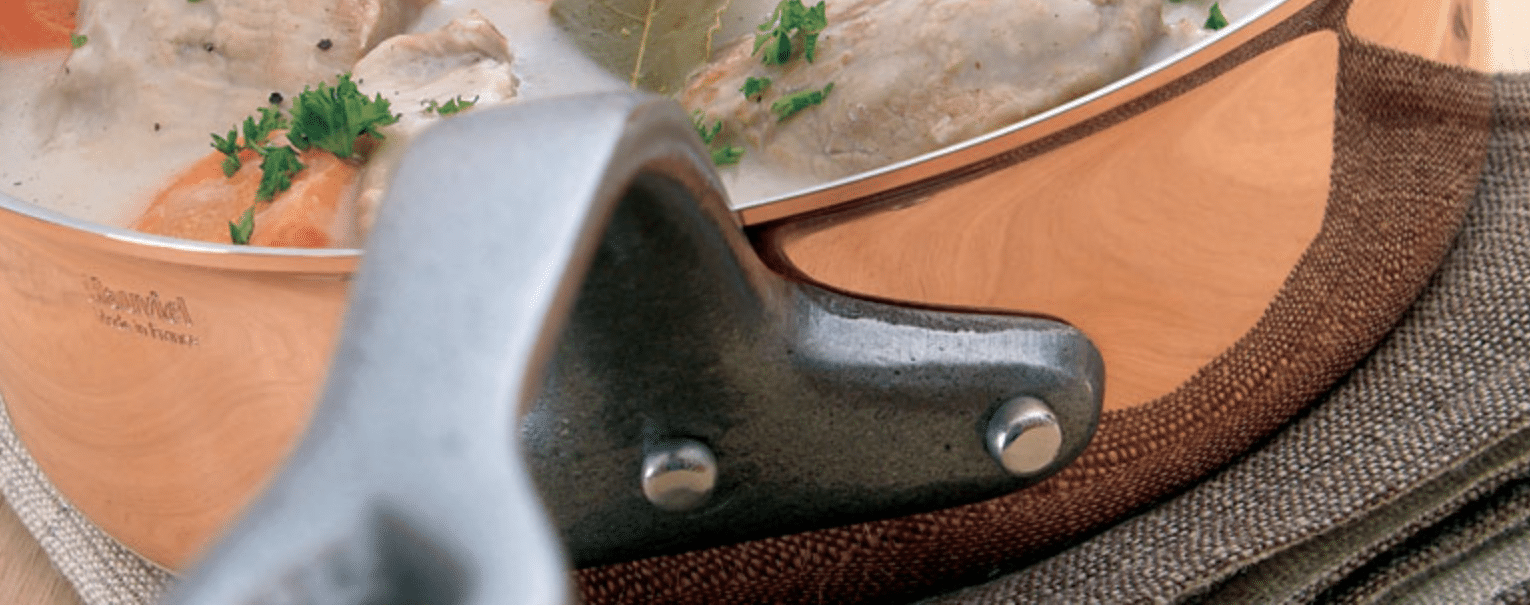
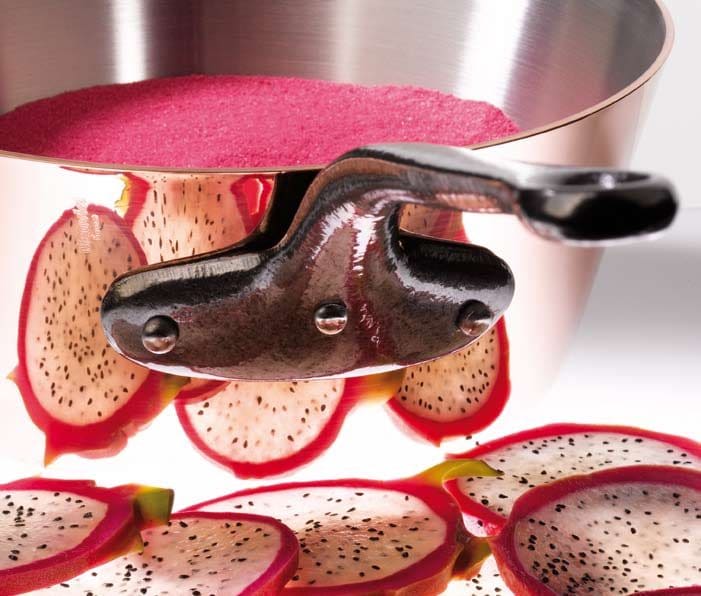
A trove of helpful information here, VFC! One note about thickness… The most accurate device to measure rim thickness is a thickness gauge with pointed (called “cusp head”) contacts. Calipers and thickness dials with flat contact points are pushed open by the concave inner radius of the pan and can measure a couple tenths of millimeters thicker than actual. Readers should be aware of this when online buying and viewing Seller pictures. You can search “Thickness Gauge 0-10×0.1mm Range Cusp Head” on Amazon or eBay to find an inexpensive one that works well for making these measurements at home.
Val, I agree completely! My first set was a flat-head style and I saw instantly how they didn’t sit flat on the curved surface and gave a misreading measurement. I replaced them with a set with little needle-like prongs. This is great advice for readers who are interested in measuring pieces more precisely.
I like this post, researching the history is interesting of course but personally I don’t place ANY financial value on stamps. Online I actively avoid stamped copper, or at least that with well known names because others will always outbid me & that’s OK as it should be in the hands of the people who most value it. I have a few named pans from flea markets where vendors generally don’t research their goods or charge a “designer label” premium.
I urge any new copper buyer to read at least the VFC buyers guide & then find their own collecting niche & not to follow the herd. Some of the very best pans are not marked. I have not done a post about my preferred type of pan because selfishly I prefer not to have competition that drawing attention might bring.
Is copper cookware a good investment? In purely monetary terms probably not. Why? The newly available online information is creating something of a bubble, the supply of quality antique copper is finite & becoming harder to source. There comes a point when so little is offered for sale that collectors tend lose interest. I have seen this happen with other collectable items. Add to this the growing popularity of induction hobs & the supply of more recently made secondhand copper pans is likely to exceed the demand.
Buy what you will use & enjoy, consider it a form of entertainment, there will always be a scrap value but anything above that……..
Roger, I’m glad you like the post. Your observations about the fluctuations in a collector market are well taken. “Buy what you will use and enjoy” is solid advice indeed, and the best refuge during pricing bubbles. Thank you as always for your comments.
A very reasonable plea! Every sentence corresponds to my own experience and practice. Of course, I was happy when I could buy a pan with interesting stamp at a price acceptable to me. Because I am interested in the history of such pans. But when I was offered an equivalent handcrafted quality, but without a stamp much cheaper, I grabbed without much thought. Such pans are preferred in my everyday life. After all, I want to guard my antique “treasures” and not wear out. It’s a good thing that I built up my “batterie” long before the current hype and now observe the market only occasionally and with increasing amazement from the sidelines.
Translated with http://www.DeepL.com/Translator (free version)
Anyone considering buying their first vintage copper pan might get the impression from our comments that they have come to the “party ” too late, so I think it important to make it clear that this is not the case.
True that to collect a specific prized manufacturer has become very expensive but there is still great usable copper to had for very little money. Some stamped pans don’t attract attention because the research has not been done yet. Cosmetic damage puts buyers off and lowers price without affecting function and can often be to some extent repaired. Pans which are not French are usually much cheaper, and those designed for 20th century commercial kitchens are sometimes not quite so elegant as those made in the past but still have a stark, brutal attractiveness of their own.
Be patient, watch, learn, wait for the bargain that will inevitably present itself. Fortune favours the prepared mind. Buy pans like the chefs of old, one by one and spread the cost as they did often over decades. In truth no one needs very many, and they don’t need to match to look great, copper is always copper coloured.
VFC recommends starting with a saute, I have to say that would not be high on my list, the kitchen requirements are a personal thing. I started with ordinary saucepans in the sizes I use most, of 1970’s manufacture .
It depends on which “party” you want to visit. The requirements for attending a party with celebrity names are pretty high now. But great fun can be had at many other parties, I agree with Roger. And sometimes there is someone there who goes on to fame (actually, most celebrities were unremarkable contemporaries at one time or another). It’s a little bit like many artists. For a long time they remained unnoticed or were ridiculed. But after their work was recognized, sometimes unfortunately only after their death, the prices of many works skyrocketed to astronomical levels.
Buy what you like, which has a good weight and a flat bottom. Prospective buyers should note, however, that vintage and antique pans are perfect for use on gas stoves. Gas stoves are not standard in all countries! I would recommend them less to not at all for electric stoves of any kind, as the often somewhat uneven or hammered bottoms do not make good contact with the cooking surface. The time to heat up can be greatly extended. Vintage pans cannot be used at all on induction stoves, as copper is not magnetic. But there are modern copper pans with “sandwich bottoms” that are suitable for this purpose.
Translated with http://www.DeepL.com/Translator (free version)
As for thickness, when cooking food on a burner, there is only one rule, the thinner the copper the more likely the tin directly under the food will melt at lower burner temperatures.
I see no reason to “store” heat energy in any copper pan. This stored energy makes controlling pan temperature difficult.
As for performance, if you crank up the heat and burn oil into the tin, eggs will stick badly to the tin ever after. If you cannot scramble and egg without it sticking to the tin, the tin has oil burned into it.
One oddity, crepe pans are best used as pancake pans, and fry pans are best used as crepe pans.
One big warning, never fry boiled pierogi on tin. I have never had good results. However, never has a risotto or a single grain of boiled rice adhered to tin. Fresh boiled pasta, that sticks like crazy to tin.
Maybe these are comments for a cooking thread. This are more collectors’ threads.
For deep frying, I would suggest un-tinned copper pot of a size just big enough to fit a typical breaded cutlet. Reduce oil amounts needed; and bits that settle on the bottom can get hotter than the oil temp and melt tin.
I have a lot of vintage copper pans. 5 sauce pans , sml to lg. lids for each pan, one lg taring pan w/ lid, roaster, lg bowl. 14 pieces in all. would like to sell all together.